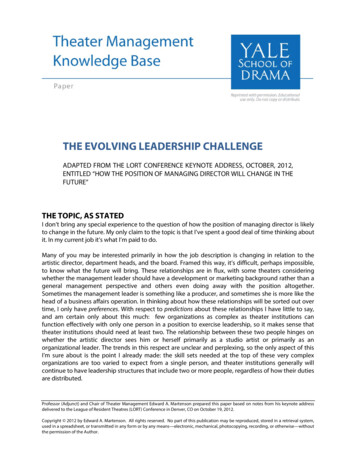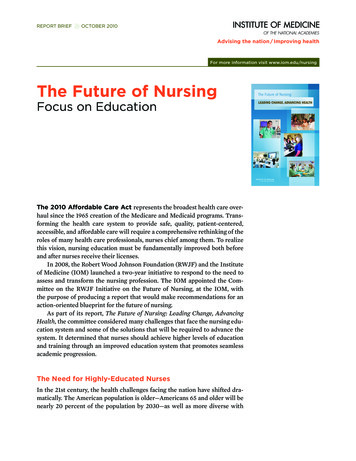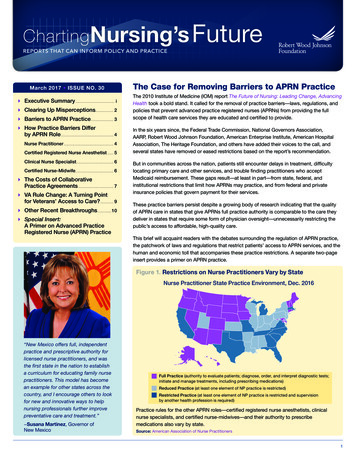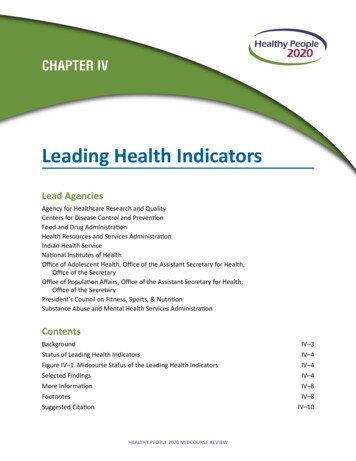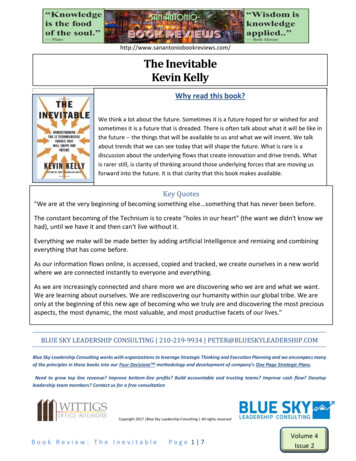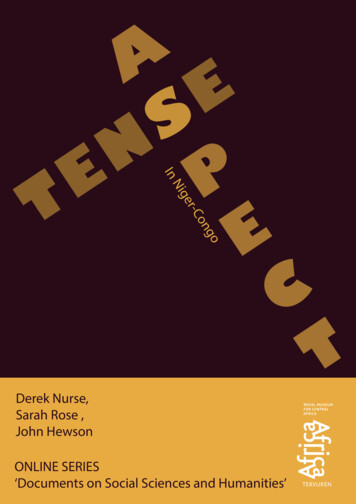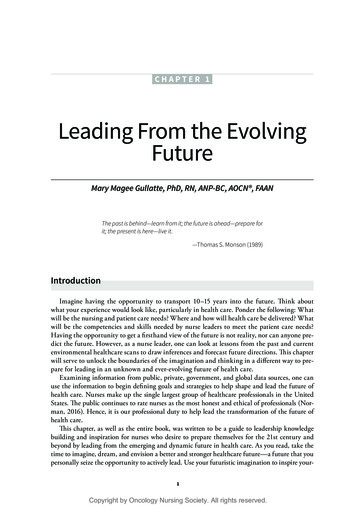
Transcription
CHAPTER 1Leading From the EvolvingFutureMary Magee Gullatte, PhD, RN, ANP-BC, AOCN , FAANThe past is behind—learn from it; the future is ahead—prepare forit; the present is here—live it.—Thomas S. Monson (1989)IntroductionImagine having the opportunity to transport 10–15 years into the future. Think aboutwhat your experience would look like, particularly in health care. Ponder the following: Whatwill be the nursing and patient care needs? Where and how will health care be delivered? Whatwill be the competencies and skills needed by nurse leaders to meet the patient care needs?Having the opportunity to get a firsthand view of the future is not reality, nor can anyone predict the future. However, as a nurse leader, one can look at lessons from the past and currentenvironmental healthcare scans to draw inferences and forecast future directions. This chapterwill serve to unlock the boundaries of the imagination and thinking in a different way to prepare for leading in an unknown and ever-evolving future of health care.Examining information from public, private, government, and global data sources, one canuse the information to begin defining goals and strategies to help shape and lead the future ofhealth care. Nurses make up the single largest group of healthcare professionals in the UnitedStates. The public continues to rate nurses as the most honest and ethical of professionals (Norman, 2016). Hence, it is our professional duty to help lead the transformation of the future ofhealth care.This chapter, as well as the entire book, was written to be a guide to leadership knowledgebuilding and inspiration for nurses who desire to prepare themselves for the 21st century andbeyond by leading from the emerging and dynamic future in health care. As you read, take thetime to imagine, dream, and envision a better and stronger healthcare future—a future that youpersonally seize the opportunity to actively lead. Use your futuristic imagination to inspire your1Copyright by Oncology Nursing Society. All rights reserved.
2 21st Century Nursing Leadershipself and empower others to a new level of leadership. Think and imagine what can be. The powerof positive and possibility thinking will help you achieve your desired outcomes. Futuristic leaders expect positive outcomes and are confident in their ability to engage themselves and others ina shared vision to make it so (Feather, 2004).Leading Change, Advancing HealthIn 2010, the Institute of Medicine (IOM, now called the Health and Medicine Division of theNational Academies of Sciences, Engineering, and Medicine) published The Future of Nursing:Leading Change, Advancing Health. The IOM committee formulated four key strategic messages: Nurses should practice to the full extent of their education and training. Nurses should achieve higher levels of education and training through animproved education system that promotes seamless academic progression. Nurses should be full partners, with physicians and other health professionals,in redesigning health care in the United States. Effective workforce planning and policy making require better data collectionand an improved information infrastructure. (IOM, 2011, p. 4)These key messages resulted in eight recommendations. For the purposes of this chapter, thefocus will be on “Recommendation 7: Prepare and enable nurses to lead change to advance health”: Nurses, nursing education programs, and nursing associations should preparethe nursing workforce to assume leadership positions across all levels, whilepublic, private, and governmental health care decision makers should ensurethat leadership positions are available to and filled by nurses. Nurses should take responsibility for their personal and professional growthby continuing their education and seeking opportunities to develop and exercise their leadership skills. Nursing associations should provide leadership development, mentoring programs, and opportunities to lead for all their members. Nursing education programs should integrate leadership theory and businesspractices across the curriculum, including clinical practice. Public, private, and governmental health care decision makers at every levelshould include representation from nursing on boards, on executive management teams, and in other key leadership positions. (IOM, 2011, p. 14)This recommendation from the IOM report focuses on nursing leadership as key to shapingthe future of health care through personal development, continuous learning, and leadership.The overall outcome from strengthening leadership development results in improved patient careoutcomes.One national strategy put forth by the Nurses on Boards Coalition, a group of national nursing organizations, is a campaign to place 10,000 nurses on governing boards by 2020 (American Nurses Association, 2014). This effort is in direct response to one of the IOM recommendations to advance nursing leadership. Realization of such a vision will require nurses prepared fora different and higher level of leadership. Strength of leadership requires personal will and passion to excel at skills such as communication, negotiation, and building positive relationships.Sanborn (2006) identified five behavioral acts of a leader: believing they can positively shapetheir careers; leading through relationships; leading from a mindset of collaboration versus control; gaining followers through persuasion and influence rather than coercion; and getting othersto follow through a shared vision rather than fear. Are you ready to lead a healthcare future thatCopyright by Oncology Nursing Society. All rights reserved.
Chapter 1. Leading From the Evolving Future 3is complex and constantly evolving? To lead from the future requires a belief in the future and avision of that future that is shared by others. Think and imagine differently.The Power of Futuristic ThinkingChris Arkenberg (2013), a research and strategy lead at Orange Silicon Valley, wrote thatfuture thinking is not about the future as much as it is about the present. The allure of futurethinking is to be able to predict with some element of certainty that what one can forecastwill happen (Arkenberg, 2013). Health care includes predictions about patient volume, qualitypatient care outcomes, revenue, expenses, staffing, and other key metrics. The ability to interpretdata sources from past and present sources is necessary to make business forecasts in dynamicand diverse healthcare systems. Prospects of the future can seem daunting at times. A sense ofcomfort exists in the known versus the unknown.What role does imagination play in future thinking? Hall (2013) espoused that the power ofimagination is essential to prospective thought and enables the mind to view the future. The authorwrote that exemplars of an imagine–think cycle are brainstorming and free thinking (Hall, 2013).This concept embodies the notion of letting one’s imagination run free to imagine and dream without restrictions. What emerges from this kind of thinking is a new vision of the future.Nurse leaders challenged with trying to stay ahead of the present may devote little timeon what the long-range future will require. One example of this complexity is staffing acrosspractice settings. Predictions assert a future shortage of nurses to meet demands across thedomains of academia, research, and service. The number of nurses who will be retiring fromthe active workforce in practice, research, administration, and academia presents a real concern for healthcare leaders. The U.S. Department of Labor (2015) projected a 16% growth inRN employment for 2014–2024. Despite the projected growth of nurses entering the workforce, more than half of a million nurses are expected to retire over the next five to eight years(Ramachandran, 2014).The current environmental scan includes an ever-increasing workforce shortage for both currentand future demands across all sectors of practice, academia, and research and inclusive of diverseprofessional specialties and subspecialties. Areas of particular concern and complexity are related toincreasing competition for dwindling research funds; personalized/individualized health care withincreased use of targeted therapies and immunotherapies for disease management; tightening of thereimbursement belt from government and private payers; adjusting to the transition to the International Classification of Diseases, 10th Revision (ICD-10); embracing top-of-license practice; andtesting new models of care for efficiency and effectiveness in achieving desired patient outcomes.Futuristic thinking and forecasting based on past and present data are key leader strategiesin planning and leading in the future healthcare environment. Therein lies the path to futuristicthinking and planning. Louis Pasteur has been credited with the quote that “chance favors theprepared mind.” How does one prepare for leading from the future? The next section will reviewleader competencies required to lead from the emerging future.Leader Competencies for the FutureNavigating and leading in a complex and ever-transforming and emerging healthcarefuture requires knowledge, talent, and skills of the nurse leader. Several chapters in this bookCopyright by Oncology Nursing Society. All rights reserved.
4 21st Century Nursing Leadershipaddress the skills and competencies required for nurse leaders to be successful in leadingchange and advancing health care for the 21st century. Chapter 14 explores and outlines theexecutive leader competencies for the healthcare future. The Oncology Nursing Society developed leadership competencies in 2012, which are available at www.ons.org/sites/default/files/le adershipcomps.pdf. These competencies are an example of how some professional nursing associations are educating and preparing their association members for higher levels of leadershipneeded for the future.The American Organization of Nurse Executives (AONE) has a number of leader competencies across various care settings and levels of leadership. The AONE competencies identify fivekey domains needed in all nurse leaders: communication and relationship building, knowledgeof the healthcare environment, leadership, professionalism, and business skills (AONE, n.d.,2015). More information about the AONE leader competencies can be found at www.aone.org h these competencies are referred to as executive competencies, they embody theoverall competencies for nurse leaders at different levels. The depth and breadth of the competencies, as well as the level of required business acumen, are dependent on the leadership leveland position of the nurse in the health system. To be a successful futuristic leader, one must havea level of mastery of the leader competencies and a vision regarding the direction of health careand one's role in leading the transformation.An emerging theory for leader competency is that of relational coordination, which alsoespouses the concept of relational leadership. Gittell (2016) describes these theoretical concepts in her book Transforming Relationships for High Performance: The Power of RelationalCoordination. At the core of coordination is communication. It is widely accepted that thesimplistic forms of communication are bidirectional, two-dimensional spans, with a senderand receiver. Now and in the future, for communication to be effective and lead to successful transformational outcomes, leaders must recognize it has to be multidimensional and multidirectional. Communication does not occur in a vacuum but instead is analogous to a busybeehive, with multiple parties sending and receiving in many directions simultaneously. Similar to the work in the beehive, communication must be organized, thoughtful, and with purpose and vision.The energizing theory of relational coordination is lending a framework to how and what constitutes the bases of successful, organized, purposeful, and visionary communication. Relationalcoordination is constantly engaging inter- and intraprofessional peers and colleagues across disciplines to engage in conversation to problem solve, create new directions, and forge shared decisions. The power of positive relationships should not be underestimated and is foundational tothe future transformation of healthcare and organizational stability.Relational leadership is creating an environment that is transformative in breaking downsilos and barriers to strengthen the bonds of coming together for a common purpose to achievedesired organizational outcomes. Forging open and honest relationships across departments anddisciplines with a shared understanding of work will support the accomplishment of strategicorganizational goals fostering improved communication, which is reflective of the high-performing organizations needed for a healthy and sustainable healthcare future.Professional Leader DevelopmentTo become a futuristic and visionary nurse leader, nurses need a level of academic preparation, experience, vision, talent, and a willingness to take risks. To start personal development asCopyright by Oncology Nursing Society. All rights reserved.
Chapter 1. Leading From the Evolving Future 5a nurse leader, one should complete a self-assessment to reveal personal characteristics that canhelp guide decisions and actions about leadership style.Kouzes and Posner (2012) identified the five practices of exemplary leadership: model theway; inspire a shared vision; challenge the process; enable others to act; and encourage the heart.Having the courage to act on one’s vision does not mean being ruthless or heartless. Regardless of your preferred leadership style, you must develop a wide repertoire of decision-makingapproaches that allow you to be directive when seeking compliance and collaborative when seeking commitment.As a leader with a vision for the future, learn to use the head (coupled with data, past experiences, and instinct) to make difficult decisions and to use the heart to implement them in waysthat speak to the needs of those affected by the decision. No one style fits all people or all situations. Taking a tough, directive stance all the time will cause one to ultimately lose the trustand support of people as they begin to feel like victims and who may attempt to sabotage wellintentioned efforts. Conversely, always taking a conciliatory and “touchy-feely” style risks losing the very respect one seeks, as one risks being perceived as spineless or unable to handle toughdecisions. It is a delicate balance. The challenge lies in knowing when to be tough-minded andfirm and when to be a follower, negotiator, collaborator, and compromiser seeking guidance andinput from others. It is easy to fall back on the familiar and comfortable personality or preferredleadership style. Although the transformational leadership style is one that most people strive topractice most often, in reality, a successful leader will use a combination of styles based on thesituation. It takes courage to modify the approach in different situations and with different people to achieve the desired managerial outcomes.Tap into the expertise and wisdom of other leaders and seek their counsel and mentorship andengage others in a process of shared leadership, where appropriate. This allows an opportunityto get commitment, or buy-in, from others and align a shared vision to support and lead change.Multiple contributors usually generate better ideas for implementation than a single leader can.One key to leading from the future is knowing how and when to engage others in creating thevision and sharing in the decision making.Another of the five leader characteristics espoused by Kouzes and Posner (2012) is creation ofa shared vision. How does one create a shared vision of the future and possibilities? This occursin two parts: (a) imagining the future by looking forward based on lessons from the past andan informed environmental scan (i.e., having a vision of what could be and sharing it with others), and (b) enlisting others by developing a shared sense of destiny in what the future can hold(i.e., appealing to the shared aspirations of others and giving life to the vision and dream). As afuturistic leader, it is important to seize authority and apply leader strengths. Authority means toinfluence that which commands respect and confidence (“Authority,” n.d.). Believe in yourselfand approach your dreams with authority. This includes conquering personal and professionaldoubts and fears. Dare to make a difference and take a risk.Leading From an Emerging FutureIn their book Leading From the Emerging Future, Scharmer and Kaufer (2013) cited two modesof learning: (a) learning from the past and (b) learning from the emerging future. Scharmer andKaufer proposed that the single most important leader capacity is “the ability to shift from reacting against the past to leaning into and presencing an emerging future” (p. 3), which requiresone to suspend personal judgments, redirect attention, let go of the past, lean into the future,and let it come.Copyright by Oncology Nursing Society. All rights reserved.
6 21st Century Nursing LeadershipLeading from the future requires risk taking—stepping out into the unknown, but notblindly. Scharmer and Kaufer espoused that three deep learning cycles are at play in visioning anemerging future (see Figure 1-1). Leaders draw on data from the past and present when makingdecisions about the future.As you prepare to gaze into the looking glass of the future, take time to pause and be thoughtful and reflective as you take in all the data elements from the past and present. As the predictions and forecasting take shape, you have the assurance in knowing that the predictive modelsof the future you desire to create were based on best data and experiences.The deep learning cycles are based on the concept of consciousness-based thoughts and behaviors. Nurse leaders are engaged in visioning and preparing for an emerging healthcare future.What will this future hold? What are the resource needs for that future? What will the patientand family needs be in the emerging healthcare future? Thinking will need to be at a level higherthan where we currently stand. Do you have the courage to transcend the mind, heart, and willto transform the future? Infinitely more questions exist that can only be explored and answeredby you as a leader. However, take caution not to try to define the answers on your own. Theemerging future in health care requires collaboration and partnership with an interprofessionalteam. The collective wisdom and vision will be necessary to prepare and lead from the healthcare emerging future. The metaphor of “thinking outside of the box” has been used in the pastto encourage transcendent thinking. Conscious awareness of what is versus what could be willdirect futuristic thinking and leadership. Reliable data also are required in the equation to lendcredibility to the leader’s visioning process.Planning With a PurposeVisioning and planning without a defined purpose is like dreaming in black and white whenthe future is in vivid color. Learning from the past to lead from the emerging future involvesFigure 1-1. Three Learning CyclesNote. Based on information from Scharmer & Kaufer, 2013.Copyright by Oncology Nursing Society. All rights reserved.
Chapter 1. Leading From the Evolving Future 7transcending three boundaries: cognitive, relational, and personal will (Scharmer & Kaufer,2013). According to this theory, emergence from these boundaries requires the leader to pauseand take time to observe, reflect, and act (Scharmer & Kaufer, 2013). One can learn from thepast while taking the time to observe the present. Pause and reflect on the current state whileenvisioning a better future.To embrace the concept of leading from the future and act on your vision, you must plan witha purpose and be prepared to take a risk. Planning is not a solo act. The leader must have the support and engagement of the team. Identify partners with whom you can share your vision andgain their support to work with you in further shaping the vision and developing goals and tactics to actualize the vision. Listen to the collective wisdom of the team and watch as your visiongains more strength and takes form. Know that the development to a new vision for the future isan iterative process and not a one-and-done process. Dr. Anil Kumar Sinha (n.d.) said, “When aplan is given wings of action, it culminates into positive result.”SummaryBeing a leader is not just about a title; it is about influence (Sanborn, 2006). Do not limit theleader that is inside you. Be an emerging leader to embrace the future and plan to be part of the leadership that will shape the future of health care. Create a shared vision of what the healthcare futurecan be and lead from your vision, placing high importance on the partnerships and relationshipswith your followers and those around you who can contribute to your success. The power of imagination and dreaming is a key factor in shaping possibility thinking. Imagination is the mind’s ability to create a vision for what could be; it takes leadership to act on that vision and engage others tofollow. This is your time—your time and your moment to step up and lead from that vision of thefuture; seize it now! Prepare for the unexpected while you expect the best. As Sam Walton, founderof Walmart stores, said, “High expectations are the key to everything” (Feather, 2004, p. 30).ReferencesAmerican Nurses Association. (2014, November 17). National coalition launches effort to place 10,000 nurses on governing boards by 2020 [News release]. Retrieved from es ace-Nurses-on-Governing-Boards.htmlAmerican Organization of Nurse Executives. (n.d.). Nurse leader competencies. Retrieved from http://www.aone.org /resources/nurse-leader-competencies.shtmlAmerican Organization of Nurse Executives. (2015). AONE nurse executive competencies. Retrieved from http://www l.Arkenberg, C. (2013). Future thinking isn’t about the future, it’s about the present. Retrieved from https://www.fastc future-its-about-the-presentAuthority. (n.d.). In Merriam-Webster’s online dictionary (11th ed.). Retrieved from tyFeather, F. (2004). Futuristic leadership A-Z. Toronto, Canada: Motivated Publishing Ventures.Gittell, J.H. (2016). Transforming relationships for high performance: The power of relational coordination. Stanford, CA:Stanford University Press.Hall, J.N. (2013). Futurlogics: A system of prospective thinking (2nd ed.). West Jordan, UT: Self Teaching Publications.Institute of Medicine. (2011). The future of nursing: Leading change, advancing health. Washington, DC: National Academies Press.Kouzes, J.M., & Posner, B.Z. (2012). The leadership challenge: How to make extraordinary things happen in organizations(5th ed.). San Francisco, CA: Jossey-Bass.Copyright by Oncology Nursing Society. All rights reserved.
8 21st Century Nursing LeadershipMonson, T.S. (1989, May). Go for it! Ensign. Retrieved from , J. (2016, December 19). Americans rate healthcare providers high on honesty, ethics. Retrieved http://www providers-high-honesty-ethics.aspxRamachandran, V. (2014, May 7). The new nursing shortage. Ozy.com. Retrieved from http://usat.ly/1kXZn42Sanborn, M. (2006). You don’t need a title to be a leader. New York, NY: Doubleday Broadway.Scharmer, O., & Kaufer, K. (2013). Leading from the emerging future: From ego-system to eco-system economies. San Francisco, CA: Berrett-Koehler.Sinha, A.K. (n.d.). Retrieved from http://www.searchquotes.com/quotes/author/Dr Anil Kr SinhaU.S. Department of Labor. (2015). Occupational outlook handbook, 2016–17 edition. Retrieved from http://www.bls .gov/ooh/healthcare/registered-nurses.htmCopyright by Oncology Nursing Society. All rights reserved.
Leading Change, Advancing Health In 2010, the Institute of Medicine (IOM, now called the Health and Medicine Division of the National Academies of Sciences, Engineering, and Medicine) published The Future of Nursing: Leading Change, Advancing Health.

